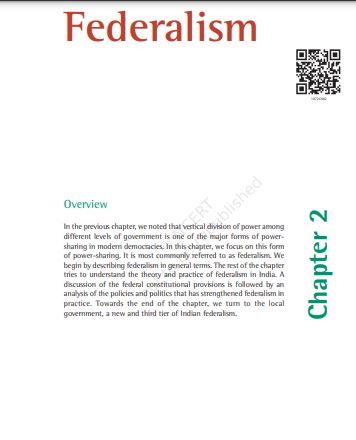‘NCERT Solutions for Class 10 Social Science Chapter 2 Power Sharing‘ PDF Quick download link is given at the bottom of this article. You can see the PDF demo, size of the PDF, page numbers, and direct download Free PDF of ‘Ncert Class 10 Social Science Chapter 2 Exercise Solution’ using the download button.
Federalism Book PDF Free Download

Chapter 2: Federalism
Let us get back to the contrast between Belgium and Sri Lanka that we saw in the last chapter. You would recall that one of the key changes made in the Constitution of Belgium was to reduce the power of the Central Government and to give these powers to the regional governments. Regional governments existed in Belgium even earlier.
They had their roles and powers. But all these powers were given to these governments and could be withdrawn by the Central Government. The change that took place in 1993 was that the regional governments were given constitutional powers that were no longer dependent on the central government.
Thus, Belgium shifted from a unitary to a federal form of government. Sri Lanka continues to be, for all practical purposes, a unitary system where the national government has all the powers. Tamil leaders want Sri Lanka to become a federal system. Federalism is a system of government in which the power is divided between a central authority and various constituent units of the country. Usually, a federation has two levels of government.
One is the government for the entire country that is usually responsible for a few subjects of common national interest. The others are governments at the level of provinces or states that look after much of the day-to-day administering of their state. Both these levels of governments enjoy their power independent of the other. In this sense, federations are contrasted with unitary governments. Under the unitary system, either there is only one level of government or the sub-units are subordinate to the central government.
The central government can pass on orders to the provincial or the local government. But in a federal system, the central government cannot order the state government to do something. State government has powers of its own for which it is not answerable to the central government. Both these governments are separately answerable to the people.
Let us look at some of the key features of federalism : 1 There are two or more levels (or tiers) of government. 2 Different tiers of government govern the same citizens, but each tier has its own JURISDICTION in specific matters of legislation, taxation and administration. 3 The jurisdictions of the respective levels or tiers of government are specified in the constitution. So the existence and authority of each tier of government is constitutionally guaranteed. 4 The fundamental provisions of the constitution cannot be unilaterally changed by one level of government. Such changes require the consent of both the levels of government. 5 Courts have the power to interpret the constitution and the powers of different levels of government.
The highest court acts as an umpire if disputes arise between different levels of government in the exercise of their respective powers. 6 Sources of revenue for each level of government are clearly specified to ensure its financial autonomy. 7 The federal system thus has dual objectives: to safeguard and promote unity of the country, while at the same time accommodate regional diversity. Therefore, two aspects are crucial for the institutions and practice of federalism. Governments at different levels should agree to some rules of power-sharing.
They should also trust that each would abide by its part of the agreement. An ideal federal system has both aspects : mutual trust and agreement to live together. The exact balance of power between the central and the state government varies from one federation to another. This balance depends mainly on the historical context in which the federation was formed.
There are two kinds of routes through which federations have been formed. The first route involves independent States coming together on their own to form a bigger unit, so that by pooling sovereignty and retaining identity they can increase their security. This type of ‘coming together’ federations include the USA, Switzerland and Australia. In this first category of federations, all the constituent States usually have equal power and are strong vis-à-vis the federal government.
| Author | NCERT |
| Language | English |
| No. of Pages | 16 |
| PDF Size | 3 MB |
| Category | Social Science |
| Source/Credits | ncert.nic.in |
NCERT Solutions Class 11 Social Science Chapter 2 Federalism
Question-1
Point out one feature in the practice of federalism in India that is similar to and one feature that is different from that of Belgium.
Solution:
India and Belgium are similar in the aspect of ‘holding together’ federations.
Question-2
What is the main difference between a federal form of government and a unitary one? Explain with an example.
Solution:
A unitary system of government is where the national government has all the powers. But, whereas the federal form of government has two powers. One at the state level and one at the central level.
Question-3
State any two differences between the local government before and after the Constitutional amendment in 1992.
Solution:
Two differences between the local government before and after the constitutional amendment in 1992 are as follows:
- Before 1992, elections to the local bodies were not held regularly. Since 1992, it is constitutionally mandated to hold regular elections to local government bodies.
- Before 1992, local bodies did not have any powers or resources of their own. After 1992, the state governments are required to share some powers and revenue with local government bodies.
NCERT Class 11 Social Science Textbook Chapter 2 With Answer PDF Free Download
